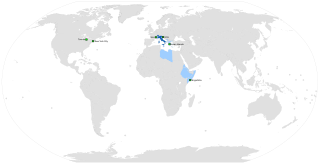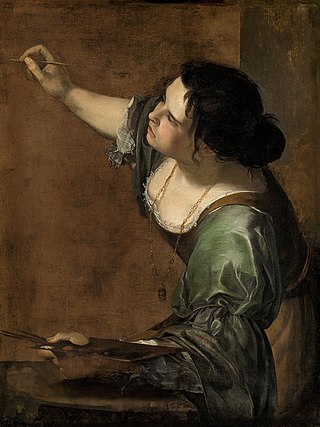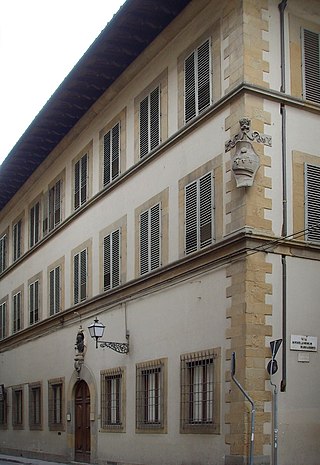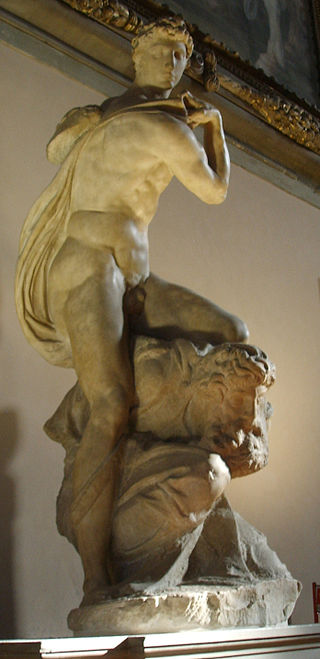
Pietro da Cortona was an Italian Baroque painter and architect. Along with his contemporaries and rivals Gian Lorenzo Bernini and Francesco Borromini, he was one of the key figures in the emergence of Roman Baroque architecture. He was also an important designer of interior decorations.

The Accademia della Crusca, generally abbreviated as La Crusca, is a Florence-based society of scholars of Italian linguistics and philology. It is one of the most important research institutions of the Italian language, as well as the oldest linguistic academy in the world.

Artemisia Lomi or Artemisia Gentileschi was an Italian Baroque painter. Gentileschi is considered among the most accomplished 17th-century artists, initially working in the style of Caravaggio. She was producing professional work by the age of 15. In an era when women had few opportunities to pursue artistic training or work as professional artists, Gentileschi was the first woman to become a member of the Accademia di Arte del Disegno in Florence and she had an international clientele.

The Accademia di Belle Arti di Firenze (ABAFI) is a state art school and the oldest public institution for fine arts education in the world. Founded in 1563 by Cosimo I de' Medici under the influence of Giorgio Vasari, it was subsequently reorganized at the initiative of the Grand Duke of Tuscany and separated from the Accademia delle Arti del Disegno in 1784. Michelangelo, Benvenuto Cellini and other significant artists have been associated with it. Like other state art academies in Italy, it became an autonomous degree-awarding institution under law no. 508 dated 21 December 1999, and falls under the administration of the Ministero dell'Istruzione, dell'Università e della Ricerca, the Italian ministry of education and research. The adjacent Galleria dell'Accademia houses the original David by Michelangelo.

Francesca Caccini was an Italian composer, singer, lutenist, poet, and music teacher of the early Baroque era. She was also known by the nickname "La Cecchina", given to her by the Florentines and probably a diminutive of "Francesca". She was the daughter of Giulio Caccini. Her only surviving stage work, La liberazione di Ruggiero, is widely considered the oldest opera by a woman composer. As a female composer she helped to solidify the agency and the cultural and political programs of her female patron.

The Galleria dell'Accademia di Firenze, or "Gallery of the Academy of Florence", is an art museum in Florence, Italy. It is best known as the home of Michelangelo's sculpture David. It also has other sculptures by Michelangelo and a large collection of paintings by Florentine artists, mostly from the period 1300–1600. It is smaller and more specialized than the Uffizi, the main art museum in Florence. It adjoins the Accademia di Belle Arti or academy of fine arts of Florence, but despite the name has no other connection with it.

Giovanni Battista Doni was an Italian music theorist, classicist and philologist who made an extensive study of ancient Greek music. He is known, among other works, for having renamed the note "Ut" to "Do" in solfège.

Domenico Passignano, born DomenicoCresti or Crespi, was an Italian painter of a late-Renaissance or Counter-Maniera (Counter-Mannerism) style that emerged in Florence towards the end of the 16th century.

Aristodemo Costoli (1803–1871) was an Italian sculptor who spent his entire career in the city of Florence. He is also known for attempting in 1843 to clean and conserve the famed Renaissance-era sculpture David by Michelangelo; unfortunately his hydrochloric acid cleaning solution removed the stone's waxy protective coating and left the surface pitted and porous. His students included Emilio Zocchi, Girolamo Masini, Augusto Rivalta and his son Leopoldo Costoli.

Girolamo Macchietti was an Italian painter active in Florence, working in a Mannerist style.

Matteo Rosselli was an Italian painter of the late Florentine Counter-Mannerism and early Baroque. He is best known however for his highly populated grand-manner historical paintings.

Mario Guiducci was an Italian scholar and writer. A friend and colleague of Galileo, he collaborated with him on the Discourse on Comets in 1618.

Casa Buonarroti is a museum in Florence, Italy that is situated on property owned by the sculptor Michelangelo that he left to his nephew, Leonardo Buonarroti. The complex of buildings was converted into a museum dedicated to the artist by his great nephew, Michelangelo Buonarroti the Younger. Its collections include two of Michelangelo's earliest marble sculptures, the Madonna of the Stairs and the Battle of the Centaurs. A ten-thousand book library includes the family archive and some of Michelangelo's letters and drawings. The Galleria is decorated with paintings commissioned by Buonarroti the Younger and was created by Artemisia Gentileschi and other early seventeenth-century Italian artists.

The Genius of Victory is a 1532–1534 marble sculpture by Michelangelo, produced as part of a design for the tomb of Pope Julius II. It is 2.61 m high and is now in the Salone dei Cinquecento of the Palazzo Vecchio in Florence.

Self-Portrait as a Lute Player is one of many self-portrait paintings made by the Italian baroque artist Artemisia Gentileschi. It was created between 1615 and 1617 for the Medici family in Florence. Today, it hangs in the Wadsworth Atheneum Museum of Art, Hartford, Connecticut, US. It shows the artist posing as a lute player looking directly at the audience. The painting has symbolism in the headscarf and outfit that portray Gentileschi in a costume that resembles a Romani woman. Self-Portrait as a Lute Player has been interpreted as Gentileschi portraying herself as a knowledgeable musician, a self portrayal as a prostitute, and as a fictive expression of one aspect of her identity.
Tommaso Rinuccini was an Italian noble, diplomat and friend of Galileo Galilei.
Allegory of Inclination is a 1615-1617 oil on canvas painting by Artemisia Gentileschi on the ceiling of the Galleria in the Casa Buonarroti, in Florence. The painting depicts a young nude female seated in the heavens holding a compass. Her light-colored hair is elaborately styled and she is partially covered by swirling drapery. A star appears above her head.

The Vocabolario degli Accademici della Crusca was the first dictionary of the Italian language, published in 1612 by the Accademia della Crusca. It was also only the second dictionary of a modern European language, being just one year later than the Tesoro de la lengua castellana o española by Sebastián de Covarrubias in Spain in 1611.
Jacopo Soldani was an Italian poet and statesman from Florence.

Francesco Rondinelli was a Florentine scholar and academic of the Seicento.


















